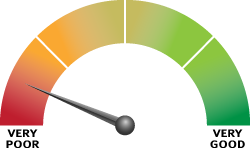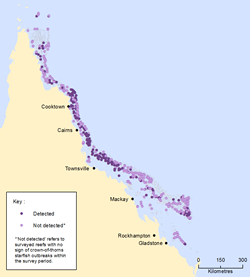Crown-of-thorns starfish pressure on the Great Barrier Reef World Heritage Area
You are viewing the archived 2015 report.
Key finding
Crown-of-thorns starfish are a major predator of coral. Evidence suggests increased nutrient loads contribute to more frequent outbreaks which result in coral cover decline and deterioration of the Great Barrier Reef's outstanding universal value (OUV).
Great Barrier Reef (information applies statewide, map locations are for reference only)
Crown-of-thorns starfish are a major predator of coral. An adult crown-of-thorns starfish can consume up to 478 square centimetres (about the size of a dinner plate) of coral each day.
Under natural conditions, it is thought that crown-of thorns starfish populations increase to outbreak concentrations in a 50 to 80 year cycle. However, human impacts may have increased the frequency and severity of outbreaks. An outbreak of crown-of-thorns starfish is considered to be occurring when they are at densities greater than about 30 starfish per hectare.
Outbreaks of crown-of-thorns starfish are one of the major causes of coral cover decline in the Great Barrier Reef. Each outbreak has resulted in severe reductions in coral cover on a regional scale, particularly in the central area.
There are indications that increased nutrients flowing into reef water from catchments loads contribute to crown-of-thorns starfish outbreaks due to increased food supply and therefore survival of their larvae. Importantly, the increased frequency of outbreaks, combined with other stresses on corals, means coral populations are increasingly unable to fully recover before the next outbreak occurs.
Growing evidence indicates ecosystem conditions may have resulted in more frequent outbreaks of crown-of-thorns starfish over the past 30 years across much of the region. These have seriously affected the ecosystem.
More information:
Indicator: Crown-of-thorns starfish
Crown-of-thorns starfish pressure on the Great Barrier Reef World Heritage Area as reported in the Great Barrier Reef Outlook Report 2014.

See also: World assessment summary.


